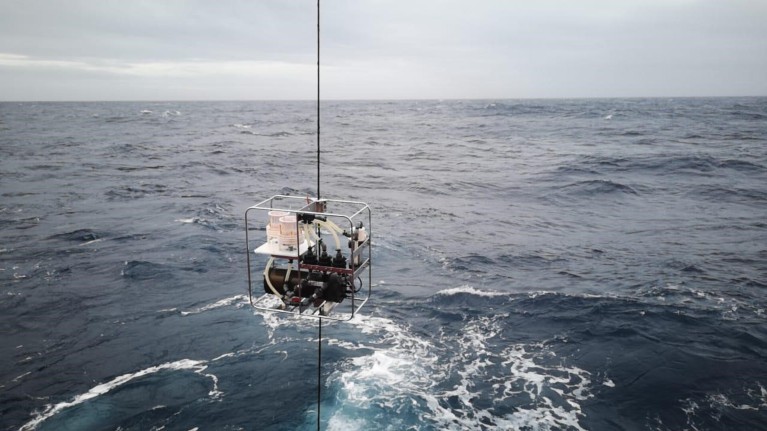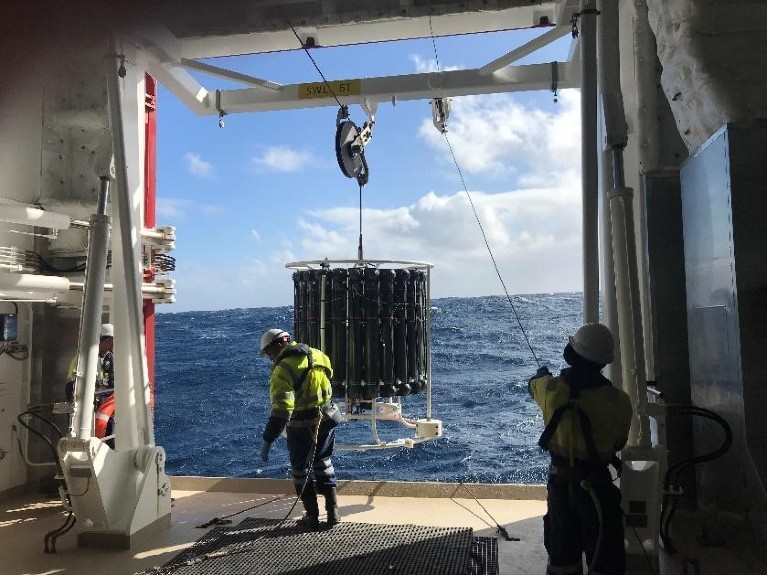
In-situ seawater pump deployed from the SA Agulhas II research vessel in the Southern Ocean. The pump filters seawater and allows the study of ocean particles between surface and deep ocean.Image credit: Ryan Cloete
Researchers have created the first full picture of how zinc circulates in the Southern Ocean, affecting marine life and the whole planet's carbon cycle. In a study published in Science1 the team warns that the effect may be influenced by a warmer climate with increased erosion, leading to more dust in the atmosphere, deposited into the oceans
Field observations from three expeditions, by South Africa’s polar research vessel, the SA Agulhas II, have enabled scientists to provide the first in-situ data verifying the importance of “scavenging” of zinc by inorganic particles in the Southern Ocean’s zinc cycle.
The Southern Ocean surrounding Antarctica is the most important region to produce biologically available zinc (called biogenic zinc) to the world’s oceans, thereby influencing primary productivity and, by implication, the oceans’ ability to absorb atmospheric carbon.
Zinc is an essential micronutrient for the growth of phytoplankton – the microscopic, single-celled plant-like organisms suspended in the top layer of the ocean. Using sunlight for energy and dissolved inorganic nutrients (such as zinc) phytoplankton converts carbon dioxide to organic carbon, important in modifying the planet’s carbon cycle. However, since the 1970s2 scientists could only speculate about the unexpected correlation between zinc and silica and not as expected between zinc, nitrogen and phosphorus in the ocean. Zinc and silica have distinct biogeochemical cycles: silica is used by diatoms to build a protective shell or “frustule” around the cell, while zinc, nitrogen and phosphorous are consumed by phytoplankton in the sunlit layer of the ocean and stored together as biomass.
Ryan Cloete, co-first author and postdoctoral fellow at the Laboratory of Environmental Marine Sciences, in Franceo, says the water samples from the Southern Ocean were collected at different depths and during the summer and winter months.

Crew on board the SA Agulhas II preparing to deploy seawater collection bottles between surface and depths of up to 4500 metres in the Southern Ocean.Image: Ryan Cloete
Working with researchers from Princeton University, the Universities of Chicago and California Santa Cruz, as well as the Max Planck Institute for Chemistry, Cloete and colleagues subjected the samples to detailed particle by particle analysis, using X-ray spectroscopic techniques at a synchrotron facility, which allowed them to study the samples at atomic and molecular level.
Cloete, a postgraduate student at Stellenbosch University, South Africa at the time, participated in two of the expeditions. He says the team found that the chemical forms of zinc changed with latitude, depth, and season, indicating a more complex zinc cycle than previously thought.
The combination of zinc and the associated particles sink below the surface layer and “we observe a decrease in organic zinc particles and a transition to inorganic zinc particles. We found that zinc is then reabsorbed onto a variety of inorganic particles such as aluminium, iron, and manganese oxides, as well as silicate particles of remnant diatom frustules.
“As a result of this ‘scavenging’ of zinc onto inorganic particles, zinc is transferred and released deeper in the water column than nitrogen and phosphorus,” he explains.
The findings have important global implications, “because the Southern Ocean acts as a central hub for ocean circulation, its processes are imprinted on water masses which are then transported to the Atlantic, Indian, and Pacific oceans. As a result, the strong zinc to silicate correlation persists throughout much of the global oceans says Cloete.”
For Alakendra Roychoudhury, co-author, environmental and marine geochemistry specialist at Stellenbosch University, the global zinc cycle should be interpreted in the context of warming oceans. “The earth system is intricately coupled through physical, chemical and biological processes. Our findings are a prime example of this coupling where biochemical processes happening at the molecular level can influence global processes like the warming of our planet,” Roychoudhury adds.
